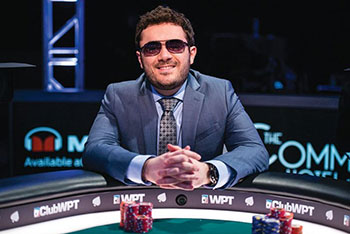TABLE DYNAMIC
Battling hyperaggressive players with three-time WPT champion Anthony Zinno
By Sean Chaffin
 Aggression can certainly be good at the poker table. Players often find prime opportunities to take advantage of more passive and tight players — with some nice benefits when it comes to their chip stacks.
Aggression can certainly be good at the poker table. Players often find prime opportunities to take advantage of more passive and tight players — with some nice benefits when it comes to their chip stacks.
But what about when the shoe is on the other foot? One player at the table is mixing it up even more with constant raises and hyper aggressiveness. Getting a read on that player may not be easy and you find yourself in some tough spots often. Playing at a table like this may leave a player with some key decisions to make against another player utilizing this style.
Play Like the Pros spoke with three-time World Poker Tour champion Anthony Zinno about this challenging situation. With more than $9.7 million in live tournament winnings, Zinno has plenty of experience at the tables on the game’s biggest stages. On the WPT alone, Zinno has more than $2.9 million in winnings and seven final table appearances and was the Season XIII Player of the Year.
The 38-year-old superstar, originally from Rhode Island and now living in Las Vegas, also added his second World Series of Poker bracelet this summer in a $1,500 Pot With more than $9.7 million in live tournament winnings Anthony Zinno knows a thing or two about poker. On the WPT alone, Zinno has more than $2.9 million in winnings and seven final table appearances.
Limit Omaha Hi/Lo event for $279,920. He came close to a third, finishing runner-up in $1,500 Seven Card Stud for $57,951. Casino Player caught up with Zinno right after the WSOP Europe, where he finished third in the 10,350 Main Event for almost $540,000.
Casino Player: How can a player deal with hyperaggressive players at the table in general?
Anthony Zinno: One of the great things about poker is that there is an entire spectrum of playing styles, and a big part of the game is learning your opponent’s tendencies. Some players are too tight, some are too aggressive, and our goal is to feel this out while we play.
Since it’s generally easier and more relaxing to play against tight opponents, it can often be frustrating, at first, to play against aggressive ones. But over time we can come to enjoy this additional challenge, and work on capitalizing on their aggression. Embrace it as a wonderful dynamic of the game.
Are there certain ways a player should adjust?
Once we identify that a player is hyperaggressive, we now must adjust our strategy to combat his. Since we expect a wider range of preflop raising from them (he’s opening with something like 9-7 off-suit in middle position), we can plan to do much more three-betting and four-betting against them.
At certain stack depths, we can even consider limping-in pre- flop in spots that we assume that they will be raising. We can sometimes slow play big hands, knowing that he might unload the clip. Anticipating this type of player’s moves is an extremely solid basis for creating a counter strategy. Over time, this ability to make correct assumptions about that next move will give us the advantage versus them.
It’s like a boxer patiently waiting for that moment when an opponent has his guard down. With hyperaggressive players, this incoming moment is inevitable. Even if we don’t get the knockout punch in, we can still enjoy landing many jabs.
Can you offer an example of this type of thinking?
Let’s say, for example, that we are in the cutoff position with J-9 ,while the hyperaggressive opponent (Opp) is in the small blind, and we have 30 big blinds. Opp has more chips than us – we call this situation “30 big bling effective stacks.”
We open to 2.3 BBs. But before we even open, we have a feeling that Opp is going to raise us – based on aggressive tendencies, the overall table dynamic, and stack sizes. Some- times we need to go with this feeling, and begin formulating our counter strategy before we even open.
For example: “If Opp raises and the big blind folds, I’m going to shove all-in over the top.” If our assessment is correct, our shove forces Opp to fold a large percentage of his range, and our mediocre hand takes down a pot without even having to see a flop.
Anything else to keep in mind against these hyperaggressive players?
This highlights the importance of paying attention to the table dynamic, even when we aren’t involved in hands. We can begin to tailor strategies that are specific to each individual player at the table. Never let their play style frustrate you – always aim to observe and adjust accordingly.
Sean Chaffin is a freelance writer in Crandall, Texas, and senior writer for Casino Player and Strictly Slots magazines. His work appears in numerous websites and publications. Follow him on Twitter @PokerTraditions or email him at seanchaffin@sbcglobal.net for story assignments.


